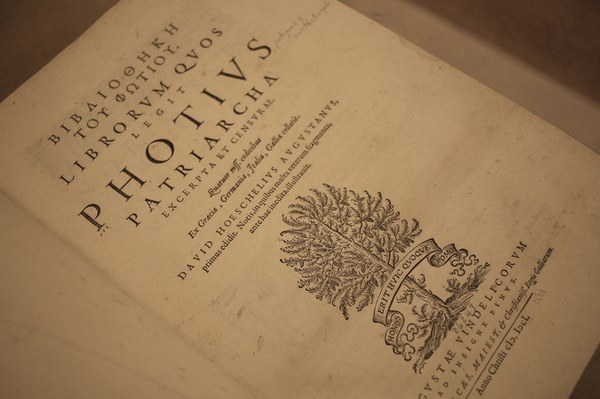Laura Pfuntner recently had a one-month research stipend at Dumbarton Oaks. A lecturer in the School of History, Anthropology, Philosophy and Politics at Queen’s University, Belfast, she was here to pursue a new research project, “Between Science and Superstition: Photius, Diodorus Siculus, and ‘Hermaphrodites’.” The project, which arose from some of her previous research, examines treatments of hermaphrodites in the Bibliotheca historica of the Greek historian Diodorus Siculus. More than half of the forty books of Diodorus’s 1st-century BCE Bibliotheca historica have disappeared, though portions of the missing sections are reproduced in a book of excerpts compiled by the Byzantine scholar Photius a thousand years after Diodorus’s book first appeared.
Sitting down to parse these excerpts, Pfuntner was confronted with a constellation of questions. What did a given passage mean at the time it was written? What can it tell us about the individuals who thought it worthy of recording or preserving, and what does it have to say about the historical moments that led the authors to their respective decisions?
Pfuntner’s work as a Roman historian centers around Sicily. She uses diverse scholarly approaches to pursue her interest in the chronological “layering” of cultures and societies on the island (including Greeks, Romans, and indigenous populations), looking at both archaeological—her dissertation examined settlement patterns in Roman-ruled Sicily—and textual angles. Before starting her current project, she researched a series of Sicilian slave revolts in the 2nd century BCE, the only source for which are Diodoran fragments collected by Photius. During this study, she began to think about the ins and outs of Photius’s excerpting of Diodorus, and found herself interested in a handful of passages about hermaphrodites.
Photius likely had access to vast bodies of literature; even if he only possessed ten of the forty books of Diodorus’s monolithic Bibliotheca, that is still, as Pfuntner puts it, “quite a lot of text.” The scale of Photius’s own Bibliotheca (otherwise known as the Myriobiblos) is massive. In it, he summarizes, reviews, extracts, or abridges nearly three hundred works by classical, late antique, and Byzantine authors, the originals of which have mostly been lost.
“These are quite lengthy passages, so Photius was obviously interested in them and took great care to preserve them,” Pfuntner explains. “What I’m thinking about now is why he did that, and what his interests in these passages were.” In doing so, Pfuntner goes against traditional evaluations of Byzantine excerpters, who are typically viewed as either “passive and indifferent” in their selection of passages, or “only interested in fanciful anecdotes.” Instead, she looks for political, personal, or historical connections between Photius’s time and Diodorus’s that might explain the selection of passages. Her work on the Sicilian slave revolts, for instance, traced their similarity to the Arab takeover of Sicily during Photius’s lifetime, which likely inspired his excerpting.
Pfuntner’s project at Dumbarton Oaks looks at the preponderance of information in Photius’s excerpts on surgeries designed to “correct or confirm cases of ambiguous genitalia.” As Pfuntner admits, this precise information is a little out of place in both Diodorus and Photius; “it’s not really something you see a lot of in nonmedical texts.” She accordingly expanded her research to include Byzantine medicine in general, and particularly the treatment of ancient medical texts in Byzantium.
To understand why Photius reproduces certain passages, it helps to comprehend the reasoning of the author he quotes. Diodorus’s conception of hermaphrodites, Pfuntner explains, tends to eschew the superstitious, because “he wants to show that they’re not dangerous prodigies or portents, that they’re not monsters or inexplicable phenomena, but that they’re actually natural phenomena.” Descriptions of surgery play an integral role in this argument. For Diodorus, surgical procedures can help to “confirm” the “true sex” of a hermaphrodite that tends to emerge over time, and “once that true sex is confirmed, the individual can go on and live their life as whatever that true sex is.”
Nearly a thousand years later, in the hands of Photius, these passages confirm another supposition. “In a way, these cases confirm traditional gender roles, in the sense that there is a clear distinction between men and women,” Pfuntner explains. “For Photius, you can’t be both male and female; you’re either man or woman.” One of the main threads of Pfuntner’s investigation concerns the theological-political implications of this stance in Photius’s time.
Eunuchs often held powerful positions in Byzantine politics, a fact Pfuntner believes is difficult to ignore when examining Photius’s excerpting. A constant debate swirled around the propriety, or simply the wisdom, of having eunuchs in positions of power, a debate Photius seems to have engaged in. “Other statements Photius makes suggest that he thinks eunuchs are a sort of corrupting presence,” Pfuntner says. “Having this person around who is neither male nor female, but of an ambiguous sexuality, is very problematic for him.”
Studying the work of an excerpter depends, of course, on the nature of the excerpting. Heavy-handed work that alters sentences, tweaks word choice, or inserts and excises opinions leaves a clearer picture of the mind of the excerpter. But Photius tends to avoid such obvious alterations; his are sins of inclusion and elision, rather than wholesale modification. Besides the occasional reworking of event chronology, glimpses into Photius’s worldview emerge largely from the simple fact of what he chose to preserve.

